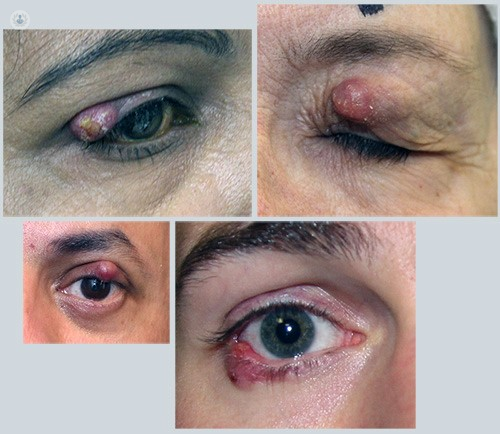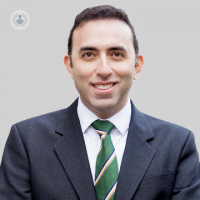Chalazion: a complete guide
Escrito por:Our eyelids are made up of lots of different types of tissue, which can each give rise to varying forms of eyelid lumps. By far the most common type of eyelid lump is the chalazion. This is a cyst that forms on an oil-producing gland in the eyelid, but fortunately, they can be removed easily with a small incision and local anaesthetic. Mr Daniel Ezra, a top ophthalmic surgeon, gives a summary of chalazion lumps and how they can be treated.

What is a chalazion?
It is a common eyelid lump that develops because of inflammation caused by oil blockage in the Meibomian gland in the eyelids. These glands secrete oil needed to maintain the tear film. If they become blocked, a swelling (chalazion) can result on either the upper or lower eyelid. Whilst a chalazion is harmless, they can cause discomfort.
What are the symptoms of a chalazion?
A chalazion is usually not painful and can vary in size as well over time. Some people with a chalazion may go on to develop a hard eyelid lump which requires removal using local anaesthetic if it has not gone away by itself and is symptomatic. Very rarely, a chalazion can become infected, which can spread to the rest of the eyelid resulting in preseptal cellulitis, requiring patients to have antibiotics.
Who gets them?
It is common for children to develop chalazions. However, if a child has recurrent chalazions, it may be indicative of undiagnosed blepharitis, which is a long-term condition that causes eyelid irritation.

A selection of chalazions showing the variability in how they can present. All of these were treated and completely resolved with curettage.
How long does it take for a chalazion to go away?
A chalazion will usually go away on their own without treatment over a few weeks or months. Whilst they can look unsightly, they do not usually represent a threat to a patient’s health. Sometimes, a chalazion can obstruct or blur a person’s vision.
How to get rid of a chalazion
To try and speed up the healing process of a chalazion, it can be helpful to use a warm, clean compress on the chalazion cyst a few times a day. This can help to reduce the size of the lump. However, it is important that you do not squeeze the lump, and it is best to avoid touching it at all.
Antibiotics:
If you suffer from other eyelid problems, such as blepharitis, you may be given antibiotic ointment to rub onto the base of the eyelashes before sleeping. This can help to calm any irritation. If an infection has resulted from the chalazion, oral antibiotics may be prescribed, however, this won’t make the chalazion go away, but the infection will.
Surgery:
Sometimes surgery is needed if the chalazion is particularly large, or it has been present for a significant amount of time. This procedure is fairly simple and only requires a local anaesthetic. After surgery, the patient can return home with an eye patch that must be removed the following day.
Other:
In some cases, steroid injections may be given, which can help to reduce inflammation and swelling of the eyelid lump.
How to prevent chalazion from forming
To avoid the formation of a chalazion, it is recommended that you clean your eyelids daily. You can do this as part of a daily washing routine, and use of a clean, warm, wet flannel with a few drops of baby shampoo to clean the eyelids before bed is helpful. This can help the eyelids to feel soothed before sleeping.


